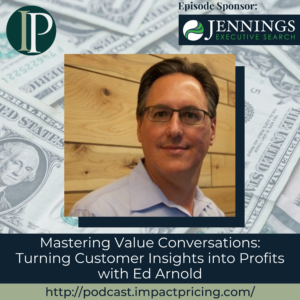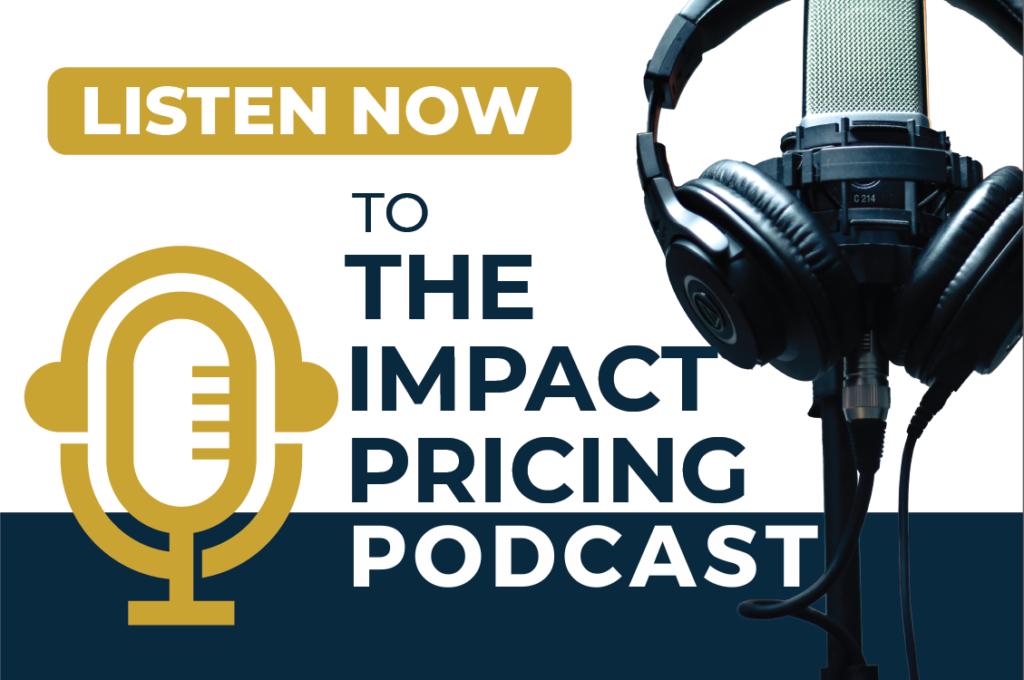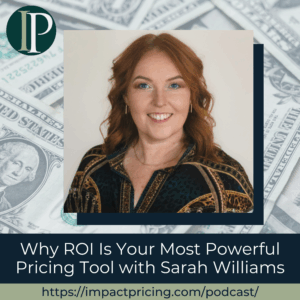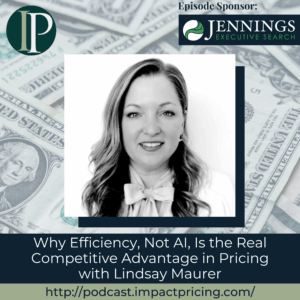Ed Arnold works with B2B companies to develop their value-based pricing strategies. His specialty is translating a company’s competitive advantage into a viable customer value pricing strategy, as well as advising on commercial execution.
In this episode, Ed shares when value conversations are most effective. He highlights the need to tailor value models to each prospect through open-ended questions that uncover key business drivers. Because when value is clearly demonstrated, price becomes a secondary concern, resulting in smoother sales and fewer pricing objections.
Podcast: Play in new window | Download
Why you have to check out today’s podcast:
- Learn why guiding customers to do their own value math is more persuasive than presenting a pre-made ROI model.
- Discover how value conversations shift the focus from cost to impact, making price negotiations smoother.
- Understand why dumping numbers on customers backfires and how to engage them in a way that builds trust and buy-in.
“As customers, we have a good sense of what a great deal is. But as sellers, we’re much less certain about what that value is. You need to have value conversations to get at that.”
– Ed Arnold
Topics Covered:
01:49 – How he accidentally got into, left, and keeps returning to pricing
04:03 – Explaining how pricing challenges often signal deeper business issues
09:11 – Why customers distrust ROI calculators
11:00 – What value conversation is all about and how to effectively go through it
13:43 – Emphasizing that trust is built through reliability and honest engagement
16:24 – How many good salespeople are there and what make good salespeople
18:29 – The importance of market focus and playbooks in sales
19:50 – Showing the most effective value conversation to have
23:43 – How he trains salespeople on value conversations
28:11 – Noting that while he focuses on larger customers, the same value-based principles apply to marketing lower-ACV products
28:40 – Ed’s best pricing advice
Key Takeaways:
“You cannot solve any pricing issue without tackling the strategy. And if the strategy is flawed, then the pricing isn’t going to help you.” – Ed Arnold
“…and this is the thing that I think about value stories. It’s not about the product. It’s about the customer. The customer is the star of the story.” – Ed Arnold
People/Resources Mentioned:
- Steven Forth: https://www.linkedin.com/in/stevenforth/
- Forrester: https://www.forrester.com/bold/
- Monitor Deloitte: https://www.deloitte.com/global/en/services/consulting/services/monitor-deloitte.html
- Leverage Point: https://www.leveragepoint.com/
Connect with Ed Arnold:
- LinkedIn: https://www.linkedin.com/in/edarnold1/
Connect with Mark Stiving:
- LinkedIn: https://www.linkedin.com/in/stiving/
- Email: [email protected]
Full Interview Transcript
(Note: This transcript was created with an AI transcription service. Please forgive any transcription or grammatical errors. We probably sounded better in real life.)
Ed Arnold
As customers, we have a good sense of what a great deal is. But as sellers, we’re much less certain about what that value is. You need to have value conversations to get at that.
[Intro / Ad]
Mark Stiving
Welcome to Impact Pricing, the podcast where we discuss pricing, value, and the undeniable relationship between them. I’m Mark Stiving and I run boot camps to help companies get paid more. Our guest today is the one and only, Ed Arnold. Here are three things you want to know about Ed before we start. His title says he’s a value-based product and pricing strategist. I’ve never heard of value-based products before, although I understand it. It’s awesome. He is an advisor at Ibbaka with my good friend Steven Forth. He spent many years at Leverage Point, so he understands value, probably deeper than most of us do. And he was on the podcast May of 2022, so two plus years ago. Welcome, Ed.
Ed Arnold
Well, thank you, Mark. It’s great to be back here.
Mark Stiving
Yeah, it’s good to have you back. I’m sure I asked this before, and you answered it before, but how’d you get into pricing?
Ed Arnold
By accident.
Mark Stiving
Just the standard answer, by the way, but go ahead.
Ed Arnold
No one grows up and says, ‘Gee, Dad, I want to be a pricing consultant when I grow up.’ I was working at the Monitor Group and had the opportunity to work with Tom Nagle and his group of consultants who came in by acquisition to the Monitor group. And at that time I was developing software products for Monitor, and they wanted to create an e-learning course on pricing. And I disobeyed orders and created a pricing tool based on Nagle’s work. And we created Leverage Point out of that, which also created a category. So I called myself a founder of a company and a founder of a category, which is nice to say. And that’s how I got started and have stayed in it, have tried to leave it, but keep coming back.
Mark Stiving
So why do you keep coming back?
Ed Arnold
I think it’s because, one, there’s a demand for it. And the thing about pricing is, you mentioned it in my title, right? Value-based product strategist. Well, pricing is part of strategy. People think about it as a tactic, and usually clients will hire consultants to fix a tactical problem. Like, we need to raise prices, right? Or adjust our pricing. And then you look at it, and it’s a much deeper, broader problem. And it ties to strategy, right? How are you positioned? Who do you compete against? Who’s your market? Are you focused or are you spread all over the place? So I think you cannot solve any pricing issue without tackling the strategy. And if the strategy is flawed, then the pricing isn’t going to help you.
Mark Stiving
Yeah. This is such an interesting concept. I think if you said, here’s the product, here’s the market, here’s the customer, here’s the situation, put a price on it. You could do that, and it’s a very tactical thing. But as soon as you start to say, how do we get the most for what it is that we deliver to our customers? Now it’s the strategy. Right now it’s the product and the positioning, and right, it’s all the pieces. Yeah. And since nobody thinks about pricing till the end, they don’t think about, well, how do we get the most.
Ed Arnold
Yeah, and like what you just said, like, well, first you think about your market and your customer, and you make a bunch of cascading choices, right? That would be something that Steven Forth would say. But you make a series of choices, right? And they’re high level choices that lead to… Then the pricing’s easy, actually, if you make those deliberate choices and they’re good choices and they’re fact-based and they’re tested, then the pricing is pretty easy. Problem is, a lot of companies don’t go through that cascade. So there’s a misalignment. And then they say, ‘Well, gosh, we’re not executing on plan. We’re not meeting our numbers. Oh, we got, it’s the price, obviously, right? Our prices are too high.’ And then income’s the pricing consultant. And so what I’m saying is that, okay, well, we can do that. But again, if you’re in the wrong market, or if your product really doesn’t have a lot of value, and I’ve done that, I’ve done value models where rather than the numbers being green, they’re red, and they’re saying, ‘Oh, you got a flaw in your software. No, software’s working.’ It’s a flaw in your product. You’re not actually providing value over what a competitor does. So what are you going to do about it?
It’s not a pricing problem, it’s a product problem. Maybe you need to redesign the product, or maybe you need to find another market or whatever. There’s a lot of choices there. So for me that’s kind of where I start with any sort of assignment. Like, what is it that you’re trying to do? What market are you trying to penetrate? How are you positioned? Right? How are you going to market all of those things? The biggest mistake I think I see is that everyone wants to cover too much ground, especially smaller companies do this, right? We were working, this is at Ibbaka, working with a client was two software companies in adjacent space. They merged, and one was serving sort of the high end of the market. The other one was serving the low end of the market. So from the investor’s point of view, ‘Oh, it’s great we just got this big piece we’re going to value.’ One of the first questions I asked them was, ‘Okay, which market are you going to give up?’ And they look at three heads, ‘Well, we’ll not give up anything.’ It’s like, well, then your exclusion will have some issues.’ And they happen. It’s not because I’m brilliant, it’s because it’s a law of Physics, law of business. You can’t be everything to everyone, right? I don’t care what your investors expect, you can’t do that.
Mark Stiving
Right, I often think in soundbites. So I’m going to give a sound bite that I’m going to pull out of what you said a few minutes ago, which I thought was brilliant. And that is, if you find pricing hard, it’s because you haven’t made all the other business decisions correctly.
Ed Arnold
I mean that’s, I wouldn’t say it quite that way, but it’s basically a symptom that you have a deeper problem, right? And I think salespeople know that probably the best because they’re out there trying to pitch things. And if they’re running into issues like that, the feedback that a price is too high, the price is too high, that’s what they hear. But if you unpack that, right, it’s not that the price is too high, there’s some other issue there. So I think one of the things that led to this particular podcast is I recently wrote an article about value conversations, right? Because usually, and look, I’ve done a lot of projects like that, and they’re good projects where they say, ‘Okay, get me a value calculator because they say the price is too high. So a value calculator will fix that, right? It might, it can help. But again if you have a good solid value prop, yeah, it will help. If you don’t, then you’re going to have to step back and look at what business we are really in and should we re-align our product and our market? So that’s how that works. So assuming that that is working well then that’s what my article was about. It was like, okay, well, just having the calculator isn’t enough. You need to do more with that to execute on it.
Mark Stiving
Yeah. By the way, I love that article. I told you that in the comments.
Ed Arnold
Thank you. That was a high praise, it made my day when I heard that.
Mark Stiving
And I want to talk about that some more.
Ed Arnold
Yeah.
Mark Stiving
Let’s start by talking about ROI calculators for a second. So one of the things I find interesting is have you ever gone online and filled out an ROI calculator and it says, ‘Hey, you’re going to make a thousand times what you invest in this.’ Just put your money here. Sure. And as soon as you do that, you’re like, I just don’t believe this.
Ed Arnold
Yeah. That’s very common.
Mark Stiving
I’m not going to give you my money. And so nobody’s going to put together an ROI calculator that doesn’t say you’re going to get some huge return.
Ed Arnold
Yes.
Mark Stiving
And so I just don’t trust them. And I think that’s true with all of our clients as well.
Ed Arnold
Yes, that’s true. Nobody trusts them. And in fact I sort of back away from saying ROI, which is kind of being a weasel, but I say payback, right? So that’s kind of what Ibbaka does in their tool. But yeah, I mean, I think payback is kind of, like, for every dollar you put in, how much money are you going to get out of this over the life of the subscription or the investment? But most people don’t, because, and one of the reasons for that is if you type in ROI in Google, in any product category, you’re going to get tons of white papers and things like that. And I worked at Forrester where they had a whole group of people who wrote these white papers. It was a really nice business for them. And they were basically value models. When I first saw it, I said, holy smokes we do these now, but they were getting paid a princely sum to essentially put together a one-size-fits-all value model that wasn’t even based on a particular customer, would be based on a bunch of customers. And it was well done. I mean, the value drivers were sound and stuff like that, but they would sell that. But the ROIs were, it was funny. They would go through the exercise and then they would put these like fudge factors in there. They would say, oh level of confidence or something like that. And they would cut that ROI down as much as possible for exactly that reason, that sort of reverse sticker shock. Too good to be true. Yeah. But that’s what happens. And so, those are well done ones, there’s a lot of not so good ROI on there. So of course, customers have become really cynical about that, and they just reject them out of hand.
Mark Stiving
And so, why, well, first off, define for us a value conversation.
Ed Arnold
Yeah. So the way I see it is that value conversation is really like the last mile of a value pricing execution. It’s where you make that value prop come to life for that customer, not for the market, not for another customer, but for that customer. It’s all about that customer, right? So what do I get from this? Right? I know people have great, ‘I want to know.’ So that’s what a value conversation is. It’s basically having that discussion before you get into showing up, showing what the ROI or the payback is. It’s having that collaborative discussion with the customer. And it’s got to be sincere. And good salespeople do this back in the day they’d call it consultative selling, right? But that is like, really listen to what your customers are really telling you, not be prepared with the pitch deck or the demo. What do they really care about? And then if it’s something that you can’t help them, they’re just being honest about it, well, can’t help you with this, but thank you for your time. I mean, who does that?
I mean, but when you do that, you develop trust. And I’ve done that with clients and said, I can’t help you with that, but I can help you find people to do that. And that’s being, I think, a good professional. So anyway, that’s what that is. You have that conversation with them, and then if you’re really good, then you start to connect the dots between, ‘Hey we work with customers with that particular problem and we have a solution that addresses that.’ And we say, we can improve things by X percent, and we could probably figure out what that’s worth to you. Maybe it’s just some additional cost we can take out, or some efficiency there. Give me some numbers.’ And then it’s sort of this back of the envelope sort of thing and say, ‘Hey and the way I look at it is I look at it in terms of digits, right? Am I saving you four digits? Eh, not a big deal. Five digits. I’ll consider you six digits. Okay, well, that sounds too good to be true. Maybe we’ll dig into that, get a little bit more precision around it.’ But it’s basically getting that sort of thing, not to prove a number, but to develop trust that we’re a vendor that’s worth talking to.
Mark Stiving
Yeah. I love this whole concept of trust. I find that when I talk to people about value conversations, they tend to think, at least the first initial reaction is, ‘Oh, you want me to go manipulate my customer?’ And it’s like, ‘No, I don’t. What I want you to do is find out is there value there,’ right? Is there value to them? Is there value to us? Right? Is this worth us having more conversations?
Ed Arnold
Well, it’s like, can I really help you? It’s basically what it is. And so, if you have no ethics at all and say, I can help everybody solve whatever problem it is, whatever they tell me, then you’re not a very trustworthy fellow and go away, right? So it takes time and patience and diligence to really prove it. And sometimes you don’t do it on the first date, right? I mean, you got to go back 2, 3, 4 or five times until you develop trust. I heard the best definition of, I can’t remember who gave it to me, was that trust is basically keeping a hundred promises. I love that. And I mean, little things like show up on time, be prepared. If you said, I’m going to get you something tomorrow, get it to them tomorrow. These are the things that I’ve always lived by as a consultant. and that’s why, and you get a reputation for being reliable. And so that’s what vendors need to do. You’ve got to keep your promises. And so if you start having that sort of engagement with people, I’ll tell you more about your problem. Because if you go and you do an ROI calculator without that trust, and you say, ‘Hey, I just need to have some information about your business in order to figure out your ROI, well, tell me how many employees, how much do they make? How much do you spend on this?’ And that they’re going to, ‘Whoa, wait a minute. Yep. I’m not going to give that to you.’ And so that hits and then people say, well, we can’t use this, Ed, because they’re not going to give us any of the data.
And it’s like, no, no, no, you’re not. So you need to have that conversation before you even talk about that to see if it’s even worth having a conversation. I was working with a client like last week, and I said, ‘Look how many value conversations are you going to have? And then how many of those do you think we’ll take that list, cut it in half. About half of them are probably worth having the next step, right? Because, let’s just say, if it’s a customer that’s very price conscious, they have no budget, this, that, and the other thing, why go to the effort of building? They’re not going to buy from you. They’re not going to buy for you at the price you want. So hey, just know that. Focus on other better clients where you can do more for them, and they’re willing to pay for it. So that’s what a conversation does. And again, it’s not a pricing thing. It’s just really good sales and good salespeople have been doing this forever.
Mark Stiving
So you say the word good salespeople, and I’m totally with you. What percent are good salespeople? And so I’m going to give you a Forrester quote since you said, ‘Hey, I used to work at Forrester.’ Yeah. Forrester says, 22% of salespeople know their customer’s business and how they can help them.
Ed Arnold
Yeah. I would say something around 20%, but yeah, that aligns with it. I think that’s true. There’s a lot of turnover in sales. They churn that all the time. So it’s a tough job. That’s why product-led growth is so sexy because you don’t need salespeople. Right? The product sells itself.
Mark Stiving
But the thing about salespeople, which I find shocking, especially given what you and I do and the fact that we have to learn how our customers run their businesses quickly. And in fact, how our customers run their businesses quickly. So the fact that a salesperson doesn’t understand how they help their customers make more profit, I just find shocking to me.
Ed Arnold
Oh, me too. I absolutely, like, do your homework, like at least look up who you’re talking to on LinkedIn, read a little bit about their business, right? Just show some curiosity. I mean, come on. I’m just as surprised as you, Mark, how they don’t want to do it or don’t feel it’s important, or, I mean, I think the worst type of salesperson, someone who immediately wants to push the demo button, to me, I ask like, how quickly, when do you show the demo? I showed it in the first call. I’m like, ‘Oh my God, you’re going to show the same demo you showed to everybody else in the same way.’ No one’s going to like that. I mean, I wouldn’t demo anything when I was selling software at Leverage Point until I knew enough about them to give them a demo that I thought would be interesting. And even then I would get something wrong… But just to do the press and record, don’t do the demo, just record a demo and then do it, but they’re not going to watch it anyway.
Mark Stiving
And that kind of goes back to where we started this conversation when you said, ‘Hey, how are you going to focus your business?’ Because if we’re going to go after every market segment and every type of customer there is, it’s really hard for a salesperson to say, ‘Yeah, I understand your business. I understand how I’m going to make you money.’
Ed Arnold
It is, and that’s why, I mean, part of the toolkit is having playbooks, right? So when I was at Forrester, that would be the thing I would do. I have a playbook for each sort of market when you talk to this company, this type of company, this type of person, stress these things, you know? so I think companies that invest in that and build up that capability, the tools and whatnot. Maybe you don’t even need an ROI calculator in some cases, but sometimes if there is sort of a buying committee on the customer side, and they’re going to want to get some kind of an ROI of some kind not that the one that the salesperson use is going to be the be all and end all. But at least it’s a data point that says, ‘Hey, based on this conversation with these sort of estimates, we think we’re going to get like a seven digit payback out of this.’
Mark Stiving
Yeah. So I’m going to say something that you might disagree with, because if you come from the Leverage Point world, I think value conversations are way more powerful when you make the customer do the math. So instead of walking in with the Excel spreadsheet and saying, ‘Hey, let’s fill this out, or the model, it’s just asking the questions and knowing in your head what that model looks like so that you can lead the customer to doing the math and saying, ‘Oh, I’m going to make this much money. Got it.’.
Ed Arnold
You may be surprised. I totally agree with you. Actually, the best way to do it, I’ll tell you the best way to do it. because, listen, I’ve had so many value conversations with customers because my work is I will actually interview my customer’s customers and record it with a value model, basically saying, they say, ‘Well, we can’t do value conversations. They’re too hard.’ I said, ‘I just recorded five of them, and each one of them I get, not to sell, but like to get them on board with, do you think this is a reasonable estimate? And I can do that in like 15, 20 minutes. And then they’re like, ‘Oh.’ But the trick to that, and I’ve learned this the hard way, is that you can’t come in with a bunch of numbers and with a solution, they’ll push back on that. Immediately, ‘There’s oh, black box. There’s something evil in here.’ You can’t have a blank slate. Because then you get the deer in the headlight look. Right? So you got to have a straw man in there. And the way I pitch it is that, ‘Hey, I did some homework on you and here’s a particular value driver, and I don’t know exactly what your margins are, but I looked up the industry average, and it’s this and your size company. I’m thinking, you probably got X number of people that do this, and this is what you’re paying them, and blah, blah, blah, blah, blah. And I think it’s roughly about this. And then they’ll look at it and they say, ‘Well, that number is wrong. Okay, let’s change it.’ We change it in real time. That’s what the software does, both Leverage Point and Ibbaka’s value do the same thing real time.
Guess what happens when the customer changes the number? It becomes their answer. That’s the magic right there. That is the magic trick you get. So you get them started if there’s like six items in the formula, let them change one and then suddenly it becomes a little bit more believable. So that’s kind of how you do it. And when you get through that, then you say, and then at the end you say, ‘Okay, so we came up with a six-digit improvement. If we do this, can we continue the conversation?’ Can we get down more through the buying process? It’s not going to be, ‘Oh, I’ll buy it.’ It’s like, ‘Okay, I got something here.’ And what you want to be able to do is, and this happens over multiple sessions, but eventually you’re making your sales contact into the advocate for the value, because it’s not, and this is the thing that I think about value stories. It’s not about the product. It’s about the customer. The customer is the star of the story. It’s your advocate saying, ‘Hey, management committee, here’s how I’m going to improve profitability in our company next year if we invest in the solution. See how that changes? This is how we do it.
Mark Stiving
And what’s amazing about that is, you can actually have an entire value conversation and never talk about a product.
Ed Arnold
If it’s done great, it doesn’t come up at all.
Mark Stiving
It’s all about what KPIs are we going to move for the customer, and how much money is that going to make them?
Ed Arnold
Exactly. And then the price becomes like, almost like a detail, then it becomes really a tactical thing. And yeah, of course, there’s always negotiation. Always, always. But it’s not going to be, ‘Oh, you have to give us 10% because we did a competitive bid and blah, blah, blah, blah. Or you got to do, that goes out the window. Because basically they say, ‘Oh yeah, we got to get this thing done.’ And then procurement will say, ‘Well, we have to.’ And they say, ‘No, no, no, wait, this has already been approved. We’re moving ahead.’ So when it’s done well that’s what it looks like. Now, not all situations go that way, but that’s the prize. That’s what you’re aiming for.
Mark Stiving
Yep. Okay. So how do you teach this to salespeople? How do you get salespeople to learn to do this?
Ed Arnold
Well, there’s a lot of things you have to do. One, they have to understand what a value model is and isn’t, right? Then they need to and usually I work with them to develop the value model. So making sure, and it’s like, well where do the value driver formulas come from? Well, a lot of them come from the marketing department. They make these claims. I always start from there and say, ‘Okay, well your marketing communications say that cut costs in here and you improve efficiency like that. And so prove it. Like, tell me why you say those things. Give me the evidence for that. And as you can expect, Mark, it’s a little thin. There’s an anecdote here, a thing here, a nice customer quote there. Okay. So we start with that. We say, let’s just assume that we may not have the proof for it, but what is the actual hypothesis that we want to say? And then we start with that. So they have to understand what those value drivers are. Then the conversation is, well then how do you get that information to make that happen?
And we talk about that initial value conversation, which is basically being able to ask those open-ended questions, listening, connecting the dots, showing some, saying, well, here’s some exam. Here’s a case that we worked on. Again, we haven’t done any Math yet. And then once they’re starting to say, ‘Okay, do you want to see what that’s worth?’ Okay. Either in a future meeting or if they want to do it in that meeting, they’ll say, ‘Well, this is kind of what this would look like.’ Can you help me refine this a little better? Maybe we can get some better information. Do you think this will work? Because a lot of times you don’t need, like, I’ll create a value model that will sometimes have like six or seven value drivers. I’m working with a client now that has like a dozen of them, and I say, you got to know which ones. There’s like two or three that you need. That’s it. But you don’t know what those are until you have a conversation. So at least figure out what those are. Is it top of the funnel? Is it retention? Is it an asset? Like, so figure it out.
Mark Stiving
I kind of like the idea of having a dozen value models or more, I don’t really care. And asking the client what’s important to them. And then you, knowing, oh, it’s these three value models. Let me pull these out.
Ed Arnold
Yeah. Well that, I mean, exactly. That’s what I’m saying. You have that conversation. So in terms of training them, they have to know what the complete value model is without showing it to them. But they have to have that. And sometimes that’s where the playbook comes in, where you have some scripts and say, if you want, if you really want to break it down and make it, and scale it and be hand holding sort of tools, then you scaffolding tools, you can have these things. And you then could say, well, if I do some homework, I’ll know that it’s pretty likely that these are the three that I will test and have that. But, again, it’s open-ended conversations. But if they say this, I may bring another one out.And then if I think there’s one that should apply, I’ll ask a direct question, do you think this will apply? So you’re having a conversation, but it’s like solving a mystery a little bit.
It takes a little bit of time and it definitely takes practice. And it can’t sound like an interrogation. It’s got to be a really friendly, ‘God, you’re so amazing, Mark. I want to know everything about you. Tell me about how you find clients and tell me what sort of issues you run into when you’re doing projects and oh, tell me another story about that.’ So there’s a lot of those sorts of things. And then I can kind of figure out, okay, he cares about this, doesn’t care about that. Okay, he has other stakeholders here that might care about this. So you kind of have to put this together. Now, the amount of time that you invest in it is directly related to what a CV you’re going after, right? You can’t do this for like a $10,000 a year subscription. It’s way too expensive. Your CAC is way too high, right? So you have to sort of depending on how big your average customer is, you have to calibrate this up and down. If it’s a large enterprise, then certainly you’re going to go all out because those customers are just so valuable.
Mark Stiving
But if we take a step back, the concepts we’re talking about apply for your marketing programs . So if you’re going after a hundred dollars ACV. Great. Use these same concepts in marketing.
Ed Arnold
Yeah. And they do it in different ways. They’ll collect the data other ways, they’ll get it from social media, they’ll test things. I mean, the tools are there to collect the data. You need to do that. I don’t focus on that part of the market. I focus more on the larger customers.
Mark Stiving
Ed, this is fascinating as always. we’re going to have to wrap it up though because we’re running out of time. Final question for you. What’s one piece of pricing advice you’d give our listeners that you think could have a big impact on their business?
Ed Arnold
Yes. Well, remember what Warren Buffet said: Price is what you pay; value is what you get. As customers, we have a good sense of what a great deal is, but as sellers, we’re much less certain about what that value is. You need to have value conversations to get at that.
Mark Stiving
Absolutely spot on. Thank you, Ed, and thanks for your time today. If anybody wants to contact you, how can they do that?
Ed Arnold
LinkedIn is the best way. And I put articles out all the time, so just reach out to me if you comment on the articles. I’d like that even better. Yeah, so, go through LinkedIn.
Mark Stiving
Great. We’ll put a URL on the show notes. And to our listeners, thank you for your time. If you enjoyed this, would you please leave us a rating and a review? Sorry for this one. Mark Herring, the Chief Marketing Officer of HiveMQ, he just left me a recommendation because I’ve done a selling value workshop and keynote for his company. And here’s a clip he pulled out, which I love:
‘I know he will tell you his superpower is pricing, but I think it’s his ability to explain complex concepts like price and value, and make them into very simple and actionable insights.’
So Mark, the check is in the mail. Thank you very much. And finally, if you have any questions or comments about the podcast or if your company needs help by getting paid more for the value you deliver, feel free to email me, [email protected]. Now, go make an impact!
[Ad / Outro]

















